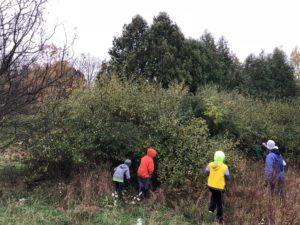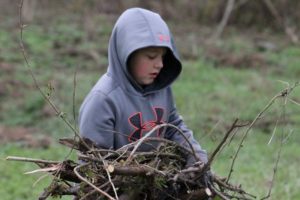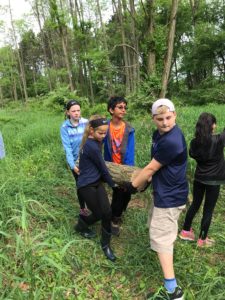Springing into Nature Play
With warmer weather on the horizon for the weekend, its time to embrace the spring weather. Let’s get outside with our kids and engage in some nature play. A key component of nature play is that there should not be too many guidelines or rules. According to one leading national organization, “At it’s very best, nature play isn’t scheduled, planned or led by adults, nor is it confined to grown-ups’ rules. Instead, it is open-ended, free time exploration and recreation, without close adult supervision. For many of us, this sort of play defined our childhoods” [1] .

Allowing the kids to just go into a natural area and explore is what nature play is all about. Imagination, exploration, discovery, and creativity are some of the foundational ideas that the children will be taking part in while they are participating in nature play.
Nature play can take place anywhere. It does not have to be an area designated specifically for nature play as long as the kids are outdoors. The area should have natural features using only materials that are in nature. In a nature play area, everything is a tool of play. Puddles are for splashing in, mud is there to jump in, trees are there for climbing, and pinecones may even be there for throwing or building.

Nature play areas should be a safe environment where kids can be themselves and have fun in the outdoors. There may be some inherent risks present but these are good teachable moments for kids to push their boundaries and discover new things. Something like climbing a tree may be a little risky, but taking chances is an important aspect of life. Encouraging your children to play and explore is an important part of their development.
The following is a list of starter ideas on how to stimulate play in the nature play area. Most likely, your child’s instincts will take over, they will decide to play however, they want, and that is the point. If they need a little prodding, try suggesting some of these ideas:
1. A portal into another world – Using your child’s imagination is a big part of nature play. To get them excited about the nature play area you can introduce them to the portal concept. The portal concept is the idea that once they enter the nature play area they are transported into another world. They have gone through a portal and now they can be anywhere their imagination takes them.
They could be trying to survive in the Amazon, they could be pretending to be the last people on the planet and have to survive, or they could be out on a camping adventure. The key to this idea is planting the seed that the possibilities are endless and that as kids they can go anywhere their imagination will take them.
2. Camouflage -This game is similar to hide and go seek, but it can be played in a more contained area. One person is selected to be it. The “it” person closes their eyes and counts to 20. While they are counting, the other players run and hide. They want to be hidden so they cannot be seen by the “it” person, but hiding players must still be able to see the “it” person. Once the “it” person opens their eyes they must try to find the hiding players. However, the “it” person must stay in one spot and cannot move to go find the hidden players.
3. Insect hunting – Many different types of insects call the play area home and bug collecting is a good way to learn inquiry and observation skills. Catching crickets or other insects can be a fun way to get up close and personal with nature.
4. Log Hopping – A favorite activity for kids has always been hopping from one log to another and trying to keep balance.
5. Water – Kids love to play and splash in the water and they can discover frogs, or insects living in the water.
6. Making boats out of bark and sticks and playing – Using the natural materials that are found in the play area children can make boats, planes, or cars and use them as part of their play activities.
7. Mud pit- Kids love getting dirty and playing in the mud; from mud pies to splashing, mud puddles are a classic outdoor activity for younger kids
8. Building forts out of sticks and branches – For decade’s kids have been drawn to the woods to make forts and secret hideaways that allow their imaginations to run wild.

Nature play is a great way for kids to go outdoors and have fun. They can just play and have fun and be in nature. Adults need to keep in mind not to structure the play too much for the kids and to allow them to explore on their own. However, safety should always be paramount and inspecting any area for any hazards is a good idea. After that, be feel free to let your children enjoy and engage in nature how they see fit.
[1] Finch, K. (2008). A Parents’ Guide to Nature Play
The post Springing into Nature Play appeared first on Michigan United Conservation Clubs.



